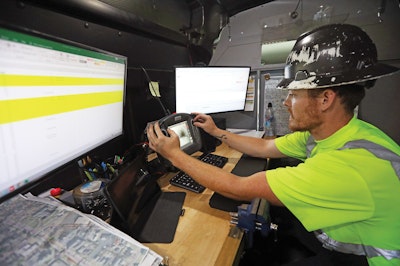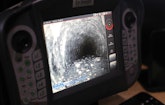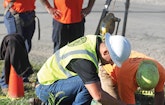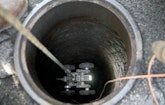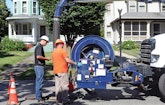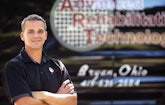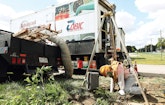
Advanced Rehabilitation Technology technician Justin Parnham uses a Vac-Con combination truck along with an Envirosight ROVVER X CCTV crawler camera to clean and inspect a 24-inch sanitary sewer line in a residential neighborhood in Toledo, Ohio.
Interested in Relining/Rehab?
Get Relining/Rehab articles, news and videos right in your inbox! Sign up now.
Relining/Rehab + Get AlertsDustin Schlachter, co-owner of Advanced Rehabilitation Technology (ART), loves to take on unique, challenging projects. “[Customers] call upon us because we’re the experts, and that’s flattering and it makes it fun.”
Those types of projects don’t come along all that often, he says. “We need those day-to-day jobs. And even though those other projects are fun, I still love our regular customers. But I would love to do more industrial or public works, specialty-type jobs.”
It seems likely he’ll get his wish, as ART, based in Bryan, Ohio, moves forward with a proven track record and willingness to adapt to whatever is required. That agility and forward-looking vision has served the company well.
Gary Mock, ART’s vice president of sales and marketing, lays out the immediate forecast: “This year looks like it’s going to be really good, believe it or not. But it’s hard to tell what next year will bring, as far as growth goes. Our goal is growth in all of the states (where we work). We probably have a 15% market penetration. Of the polymers, epoxies and polyurethanes, we think we have a pretty good lead on most of them. I would love to see that market penetration be above 25% and possibly 30%. Fifty percent of the market is plain cement in the wastewater manhole rehabilitation industry.”
The company has its work cut out for it as a provider of environmentally sound, cured-in-place pipe repair technologies for a wide variety of surfaces, mechanical requirements and operating conditions.
ART runs two Vac-Con combination trucks and two Envirosight mainline CCTV trucks equipped with standard mainline camera crawler combinations and a lift for inspection of sanitary mainlines, as well as large-diameter trunk lines or storm drains. The rigs share a single lateral-launch camera for lateral line inspection.
Apart from the crowd
ART specializes in high-quality flexible liner systems that have proven to be a cost-effective, no-dig alternative to the replacement of water, sewer, wastewater and holding systems, including manholes, vaults and other components. Its go-to solutions are polyurea-based spray-applied liners, including flexible, high-build and multilayer coatings that provide new surface integrity while strengthening existing infrastructure. These coatings may also be used on newly installed structures to proactively prevent future deterioration.
The company uses the OBIC family of environmentally friendly products that creates a seamless, monolithic coating, including:
- OBIC 1000 liner system – a tough, flexible polymer that is easily applied and fast curing; a solution for repairing and preventing damage to municipal and industrial sewer lines and waterlines
- OBIC 1200 Culvert Armor – frequently used to repair damage to partially deteriorated culverts
- OBIC 1100PW – a long-lasting, fast-set solution designed specifically for applications that must be U.S. Department of Agriculture food and beverage compliant; an ANSI 61-approved barrier material for potable water
The adoption of such no-dig lining technologies was no accident. ART always does its due diligence when adding products and services, and it’s not something the company does often. The process is approached seriously because ART knows any new introductions will have to be worth the disruption they will cause in a streamlined production process.
“When you’re vetting the market, you’re looking at what’s out there. Will somebody use this service? And, of course, we’ve grown up in this bid world for municipal work, so we look at that,” Mock says. “We look at the competitors; then we go on to vet the equipment. That process includes reviews from others we know in the industry, as well as product reps coming in and describing their service and equipment. And occasionally we’ll demo some of the equipment [before making a purchase decision].”
Unusual projects
Schlachter and Mock both enjoy going after projects that aren’t run-of-the-mill, because they enjoy the challenges involved. Often, figuring out how to safely and effectively apply their infrastructure rehabilitation products is at least as taxing as the application itself. Project location, terrain, climate, deadline and duration are all factors they must navigate to successfully complete each job.
Schlachter explains that oftentimes the company becomes the chosen contractor due to one particular characteristic of ART’s coating system: “It’s a quick cure. With polyureas, the liner is tack-free within 10 to 15 seconds. When a client has a complicated project where it’s critical to turn off bypass immediately, our product doesn’t require the cure time others do.”
Recently, ART did a project on a Michigan golf course. “It was a ‘hurry up, we need your help’ kind of thing,” Mock says. The general contractor was in a time frame dilemma and needed to avoid the liquidated damages contract clause that would have been activated by missing the project deadline.
The golf course’s sanitary sewer system mainline was being rehabilitated by Insituform Technologies, and ART was lining the manholes as a subcontractor. The company had already committed to working through the weekend to beat the deadline, when a long, heavy rainstorm struck.
A large bypass system had already been set up, with large pumps and more than a mile of large pipe. Nevertheless, ART still had to complete its part of the job in just three days, a process that would normally take 10.
ART was able to help the contractor finish the job on time and also saved him money by allowing the bypass pumps to be turned off quicker since the curing time for the polyurea system doesn’t need hours or days. The system was back in service quickly.
Large mats were placed across the golf course so the contractors’ trucks wouldn’t cause damage to the carefully manicured sod on the greens. The rain continued through the weekend and was so heavy that the mats floated away. Water was coming up so fast that one of ART’s trucks barely got across the green in time. It was just another day of on-the-fly problem-solving for the ART crews.
Bay City, Michigan, was the site of another challenging rehabilitation project. A sewage receiving structure had a large manhole — 55 feet deep and 8 feet across — that trucks use to dump their loads into the sanitary system. The structure was corroded, and the city chose ART’s liner because it wanted something that would provide many years of service so that it wouldn’t have to tackle the project again anytime soon.
With the size of the structure and the preparation involved, Mock recalls, “We needed to have a big safety plan. The opening on top wasn’t such that we could get a large, manned basket down in there with a crane to get the work done. One had to be purchased that was more like a mine rescue basket, so some extremely special safety equipment was needed.” The team also had to come up with a design for the equipment and how to operate it. “We worked in conjunction with the owner to come up with a plan that safely allowed manned entry to get that liner system installed.”
Schlachter adds: “Once we got started, it was only a four-day project. Part of that was due to the engineering and the days we spent on site preparing for [the actual liner application].”
Visibility and responsibility
Probably one of the most memorable projects in ART’s portfolio was the rehabilitation (nearly an entire structural rebuild) of an iconic water fountain in the historic Union Terminal complex in Cincinnati. Being awarded such a high-visibility project is certainly a feather in any contractor’s cap, but when it’s for a much-beloved and culturally significant structure as this, it can also be a nerve-wracking feat to complete.
A fountain was located in the courtyard of the complex, central to all other buildings. It was built over the top of an underground children’s museum. Leakage in the fountain’s catchment pan was discovered through ceiling seepage into the museum below.
Because so much of the fountain structure involved vertical wall surfaces, other contractors shied away. The terminal’s grant funding for the rehabilitation hinged on the contractor using historically correct materials or as close to them as was currently available. No one had been able to imagine a waterproofing membrane that would both do the job of preventing seepage into the inevitable cracks in the basic concrete form foundation and allow the surface application of the historical grainy finish.
All contractors and engineers consulted had predicted that there was no such material that wouldn’t either creep or eventually separate from the top finish coats. It was just the sort of challenge ART is known for and that Schlachter and his crews relish. They worked with another engineer who believed a polyurea might be able to do the job, and they did several on-site application tests over several months during a brutal Cincinnati winter.
The end result was that the spray-applied membrane worked but required that the entire structure be laser-measured, completely deconstructed and rebuilt, literally from the ground up. But it paid off, with ART’s dedication and skill being recognized by the city for saving the iconic landmark.
Looking ahead
Both Schlachter and Mock agree that they expect to carry ART successfully into the future with more of what they’ve always done.
“What I do to help try to grow our business is let customers know we have something that can help, and we are honest with people about how it can help them,” Mock says. “We’re fair in our pricing. We want to make a fair profit, but we don’t gouge, and I think that’s the biggest key to our success — being honest with people. They can read you. They respect you for being honest.”
Schlachter agrees and adds, “Two of the key personal core values for me are being in business with people we trust and doing good for the kingdom and quality work. I try to incorporate my faith into building the business, to make sure we’re doing business for the right reasons and with the right people, and allowing that to be a guiding factor for me. We like to be business-minded but purpose-driven.”
Marketing in the time of COVID-19
As vice president of sales and marketing, Gary Mock has given a great deal of thought to how the company will move forward with promotional outreach during periods of social distancing.
“We’ve discussed how we’re going to work in this new era,” he says. “One of the things that’s difficult for me — because I’m an old man — is the part about that physical connection and putting the product in prospects’ hands. For the most part, the most successful thing for us has been to actually go out and knock on doors and meet people.
“It may sound inefficient, right?” he asks. “If I’m going to buy an advertisement, how productive is that compared to going out and knocking on a door and showing up with this material that’s difficult to explain in a picture? It’s much easier to put it in someone’s hands and let them twist it and try to tear it and discover how tough it is, even while retaining this flexibility. So our biggest marketing effort is actually to go out and meet with people, make cold calls or be at industry events and trade shows.
“We’ve discovered that many times, when we make a telephone call … it’s easy for someone to say, ‘Well, tell me about it now. We’re on the phone,’ or ‘I don’t know if I have time. Why don’t you call me again another time?’
“Whereas most people — at least in the past, before the coronavirus — are nice. For most, if you show up with a smile and say, ‘Hi, can I speak to you for just a few minutes?’ will give you the time of day. And if they’re not the right person, they’ll direct you to whoever is. That’s been successful for us.”
Trade shows were also a way to get the product physically in people’s hands, making it easier to explain its benefits.
“Most people don’t know what polyurea is. You can explain it as a spray-applied truck bed liner, and many guys will get that. But when you show it to them on a brick that you broke with a hammer and it’s all held together by the liner because the stuff is so tough and then you compare that to hitting another product with a hammer, they really get it and like it. So the trade shows were a big [part of our successful marketing].”
But Mock knows that now ART will have to adjust, like everyone else. “We’re going to need to come up with some better print and videos that show (the product). If you look at YouTube and some of the polyurea things out there (e.g., blast mitigation, when you set up an explosive device in front of a concrete block wall, blast it, and blow it up, but the wall stays together because of the polyurea on there), it’s pretty impressive. I don’t know if we can make a video like that, but we need to make something that provides that shock and awe and shows the benefit of this product compared to anything else that’s out there.”
Regardless the actual outreach tactics, one of the firm’s partners, Dustin Schlachter, believes part of the success isn’t just the message or the medium, but who’s delivering it. “We’re industry guys. We’re not just sales guys who are going out and meeting the end users, the municipal guys. I think they respect guys who are from the industry, who are providing a long-term service.”
